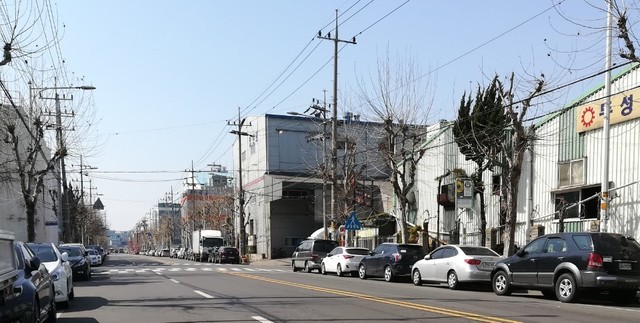 |
|
An automotive parts supplier in Incheon’s Namdong Industrial Park. The crisis at GM Korea has led to a reduction in orders up to 50 percent. (by Hong Dae-seon, staff reporter)
|
Small and medium-sized businesses feeling the effects from the tug-of-war between GM and the government
One month after GM’s announcement of its plan to shutter a factory in Gunsan operated by GM Korea, the shock has spread beyond Gunsan in North Jeolla Province to the Incheon area, the location of GM Korea’s corporate headquarters and its Bupyeong factory. This factory is GM Korea’s biggest operation, with the capacity to produce 500,000 vehicles a year. Needless to say, the factory has an outsized impact on the local economy. When I visited Incheon’s Namdong Industrial Park on Mar. 14, there were few signs of its past energy. GM has reduced its orders by as much as 50%, landing a body blow on these factories and sending their utilization rate plummeting. “Because of the GM crisis this year, sales have declined by 20%, and sometimes as low as 50%. At this rate, we’re all going to go out of business,” admitted Mun Seung, CEO of Daseong, a company that has been manufacturing automobile parts at Namdong Industrial Park for 25 years. Mun described these difficulties at a meeting of an emergency action committee for GM Korea suppliers that was held at the National Assembly on Mar. 16, but no one had any good answers. “Since we’re not a party to the negotiations, our only option is to go around and beg for help. We hope the government and GM will both take the high road here.” Unlike the Gunsan factory, the Bupyeong factory has a lot of work to do. Backed by strong exports of the Chevrolet Aveo, a subcompact sedan, and the Chevrolet Trax, a small SUV, the factory has maintained a utilization rate of 100%. But as GM pulls out of one overseas business operation after another and with domestic sales in free fall, the company’s suppliers have taken repeated hits to their businesses. In February, amid rumors of a pullout, GM Korea’s domestic performance tumbled 48% year on year. “Everyone is on edge because of rumors going around that unless we’re given more orders or assigned a new model, the first and second plants at the Bupyeong factory will have to merge, never mind the Gunsan factory,” workers at Namdong Industrial Park said. The managers of small and medium-sized parts suppliers complain that not only is it harder to take out bank loans, but the discount on their trades receivable has sharply decreased. “Banks are asking for collateral on the grounds that our credit rating has fallen, but SMEs don’t have that kind of collateral. Some companies are in such a cash crunch that they can’t pay their electricity bill,” said the CEO of a GM Korea part supplier who asked to remain anonymous. A survey by the Korea Auto Industries Cooperative Association (KAICA) found that the factory utilization rate at GM Korea’s primary suppliers was down to 50-70% while sales had also dropped about 20-30% compared to the previous year. ”Hidden champions” may lose competitive edge if GM crisis is prolonged There are growing concerns that even “hidden champions” – small companies that have achieved success through technological prowess – could lose their competitive edge if the GM crisis is prolonged. JPC Automotive, which manufactures parts for vehicle interiors, was identified as a hidden champion by the Industrial Bank of Korea, among others, based on its key technology patents. The company had been running its factories night and day with the goal of achieving 100 billion won (US$93 million) in sales, but the GM crisis has put a halt to that ambition. “Falling sales are bad enough, but if GM leaves the country than all the technological expertise we’ve gone to such trouble to accumulate will just go to waste. It makes my blood boil,” company CEO Yun Gwan-won said. GM Korea accounts for 17% of exports and 13% of manufacturing industry sales in the Incheon area. There are 521 primary, secondary and tertiary suppliers in the area, with 50,000 employees. Considering that the company is a pillar of the Incheon economy, the local government, as well as commercial and manufacturing interests in the region, are scrambling to devise a response. The Korea Development Bank (KDB), which is GM Korea’s second largest stockholder, finally launched its due diligence inspection of GM Korea this week. While the KDB has not completely resolved its disagreement with GM about the scope and the period of this assessment, it concluded that the assessment could not be put off any longer. The government and the KDB maintain that they will not provide GM with financial assistance unless the company comes up with a long-term plan for normalizing business operations that is both specific and sustainable. “We thought things were strange from the moment GM started developing vehicles in Korea and producing them in other countries. This isn’t a problem that can be resolved through financial aid alone. We need to come up with a plan for GM Korea’s long-term survival,” said Lee Jong-seung, CEO of Changwon, a primary parts supplier for GM Korea. By Hong Dae-seon, staff reporter Please direct questions or comments to [english@hani.co.kr]






